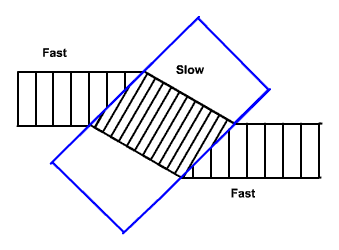|
When visible light passes through a
transparent material such as glass, its velocity changes
according to the Index of Refraction of the material.
This slowing is caused by the electrical fields in the
material. When the beam of light enters the material at
an angle, it is bent or refracted as a result of the
decrease in velocity. The refraction is similar to the
change in direction of soldiers marching into a muddy
field.
Questions you may have include:
Light slows down
Visible light is electromagnetic
radiation or waveform. The speed or velocity of light in
a vacuum is about 186,000 miles per second or 300,000
kilometers per second. The velocity of light or other
electromagnetic radiation is typically slower when it
passes through a transparent material. For example, the
speed of light in water is about 140,000 mi/sec or
226,000 km/sec.
The reason electromagnetic radiation is
slower when the light passes through a transparent
material such as water or glass is because of the effect
of the electrical fields surrounding the electrons and
nuclei of the atoms in the material. The fields almost
act like a "friction" on the light wave, thus slowing it
down. It is like trying to walk through a muddy field.
The speed of light in a transparent
material is slightly different for each wavelength. That
characteristic is called dispersion and responsible for
the creation of the spectrum in a prism. (See Dispersion
of Light for more information.)
Index of refraction
A measurement of how much the speed is
slowed is indicated by the Index of Refraction of the
material. The Index of Refection (i) of a material
equals the speed of light in a vacuum (c) divided by the
speed of light in the material (cm). Since
c and cm are
in meters/sec. or miles/sec., i is just a number or
ratio.
i = c / cm
Or, if you want to find cm:
cm = c / i
Since cm varies slightly with
wavelength, the value for green light is used as a good
average number.
The following chart shows the index of
refraction for several materials:
| air |
1.0002926 |
| water |
1.333 |
| glass |
(typical) 1.5 to 1.9 |
| diamond |
2.419 |
Usually, the index of refraction for air
is just considered as 1.00, since the amount greater is
too small to make a difference in most calculations.
For example, the speed of light through
a piece of glass with an index of refraction of i = 1.5
is:
cm = 186,000/1.5 = 124,000 miles/sec.
or
cm = 300,000/1.5 = 200,000 km/sec.
Bending light
When a beam of light passes at an angle
from one material to another, the beam is bent or
refracted according to the difference in speed in the
second material compared with the first. Calculation of
the refraction angle is determined according to Snell's
Law.
Considering a group of soldiers marching
into a muddy field at an angle to their direction of
travel can explain how a beam of light will be
refracted. As the soldiers try to stay in a line, the
direction of travel would bend because marching in mud
would slow them down, starting with the first group to
enter the field. Then, as they leave the muddy area,
they go to their original speed, thus bending the
direction of travel again. The original direction and
the final direction are parallel but displaced.
The same thing happens when a beam of
light enters a transparent material at an angle.

Light moving from air to glass and back
to air
You might wonder if the color of the
light changes when moving into another material. In the
picture above, it shows that the wavelength seems
shorter in the material where the light travels slower.
Actually, your eyes perceive color by the frequency
(waves per second) and not wavelength.
The relationship between the speed of
light, frequency and wavelength is:
c = ν λ
where ν is the frequency (Greek letter
nu) and λ is the wavelength (Greek letter lambda).
Now the speed of light in the material
is:
cm = ν λm
where λm is the wavelength in the
material
But the frequency ν remains the same and
thus the perception of color is the same. You can verify
this by looking at objects when you are swimming under
water. The speed is slower under water, but the color
remains the same.
You can see this effect by putting a
pencil in a glass of water. It appears as if the pencil
is broken, but it is just because of the refraction of
light.

Pencil in water glass
The light from the pencil is refracted
as it passes from the water to the glass to air, causing
it to be displaced. Since the surface of the glass is
curved, the water in the glass also acts as a magnifying
glass, slightly enlarging the pencil.
The speed of light in a material is also
a function of the wavelength or frequency of the light.
That means that the Index of Refraction is different for
different wavelengths. In glass, the speed of light--and
thus the Index of Refraction--changes by about 2%
between primary colors of visible light (red, yellow,
orange, green, blue, indigo, violet).
To avoid confusion, the Index of
Refraction is usually stated as an average or for the
color green. The effect of the different speeds shows up
in the effect called dispersion, where the light is
refracted at different angles for each color.
When visible light passes through a
transparent material such as glass, its velocity changes
according to the index of refraction of the material.
The index of refraction of air is about 1.00 and that of
water is 1.33. When the beam of light enters the
material at an angle, it is bent or refracted as a
result of the decrease in velocity. The property of
refraction is important in the making of lenses. |